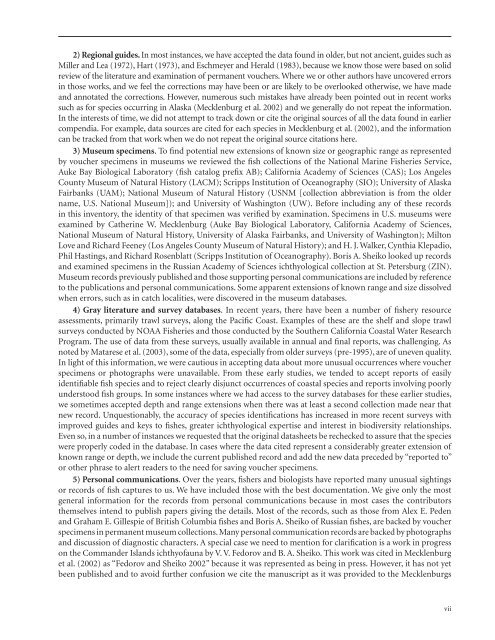Untitled - Alaska Resources Library
Untitled - Alaska Resources Library
Untitled - Alaska Resources Library
Create successful ePaper yourself
Turn your PDF publications into a flip-book with our unique Google optimized e-Paper software.
2) Regional guides. In most instances, we have accepted the data found in older, but not ancient, guides such as<br />
Miller and Lea (1972), Hart (1973), and Eschmeyer and Herald (1983), because we know those were based on solid<br />
review of the literature and examination of permanent vouchers. Where we or other authors have uncovered errors<br />
in those works, and we feel the corrections may have been or are likely to be overlooked otherwise, we have made<br />
and annotated the corrections. However, numerous such mistakes have already been pointed out in recent works<br />
such as for species occurring in <strong>Alaska</strong> (Mecklenburg et al. 2002) and we generally do not repeat the information.<br />
In the interests of time, we did not attempt to track down or cite the original sources of all the data found in earlier<br />
compendia. For example, data sources are cited for each species in Mecklenburg et al. (2002), and the information<br />
can be tracked from that work when we do not repeat the original source citations here.<br />
3) Museum specimens. To find potential new extensions of known size or geographic range as represented<br />
by voucher specimens in museums we reviewed the fish collections of the National Marine Fisheries Service,<br />
Auke Bay Biological Laboratory (fish catalog prefix AB); California Academy of Sciences (CAS); Los Angeles<br />
County Museum of Natural History (LACM); Scripps Institution of Oceanography (SIO); University of <strong>Alaska</strong><br />
Fairbanks (UAM); National Museum of Natural History (USNM [collection abbreviation is from the older<br />
name, U.S. National Museum]); and University of Washington (UW). Before including any of these records<br />
in this inventory, the identity of that specimen was verified by examination. Specimens in U.S. museums were<br />
examined by Catherine W. Mecklenburg (Auke Bay Biological Laboratory, California Academy of Sciences,<br />
National Museum of Natural History, University of <strong>Alaska</strong> Fairbanks, and University of Washington); Milton<br />
Love and Richard Feeney (Los Angeles County Museum of Natural History); and H. J. Walker, Cynthia Klepadio,<br />
Phil Hastings, and Richard Rosenblatt (Scripps Institution of Oceanography). Boris A. Sheiko looked up records<br />
and examined specimens in the Russian Academy of Sciences ichthyological collection at St. Petersburg (ZIN).<br />
Museum records previously published and those supporting personal communications are included by reference<br />
to the publications and personal communications. Some apparent extensions of known range and size dissolved<br />
when errors, such as in catch localities, were discovered in the museum databases.<br />
4) Gray literature and survey databases. In recent years, there have been a number of fishery resource<br />
assessments, primarily trawl surveys, along the Pacific Coast. Examples of these are the shelf and slope trawl<br />
surveys conducted by NOAA Fisheries and those conducted by the Southern California Coastal Water Research<br />
Program. The use of data from these surveys, usually available in annual and final reports, was challenging. As<br />
noted by Matarese et al. (2003), some of the data, especially from older surveys (pre-1995), are of uneven quality.<br />
In light of this information, we were cautious in accepting data about more unusual occurrences where voucher<br />
specimens or photographs were unavailable. From these early studies, we tended to accept reports of easily<br />
identifiable fish species and to reject clearly disjunct occurrences of coastal species and reports involving poorly<br />
understood fish groups. In some instances where we had access to the survey databases for these earlier studies,<br />
we sometimes accepted depth and range extensions when there was at least a second collection made near that<br />
new record. Unquestionably, the accuracy of species identifications has increased in more recent surveys with<br />
improved guides and keys to fishes, greater ichthyological expertise and interest in biodiversity relationships.<br />
Even so, in a number of instances we requested that the original datasheets be rechecked to assure that the species<br />
were properly coded in the database. In cases where the data cited represent a considerably greater extension of<br />
known range or depth, we include the current published record and add the new data preceded by “reported to”<br />
or other phrase to alert readers to the need for saving voucher specimens.<br />
5) Personal communications. Over the years, fishers and biologists have reported many unusual sightings<br />
or records of fish captures to us. We have included those with the best documentation. We give only the most<br />
general information for the records from personal communications because in most cases the contributors<br />
themselves intend to publish papers giving the details. Most of the records, such as those from Alex E. Peden<br />
and Graham E. Gillespie of British Columbia fishes and Boris A. Sheiko of Russian fishes, are backed by voucher<br />
specimens in permanent museum collections. Many personal communication records are backed by photographs<br />
and discussion of diagnostic characters. A special case we need to mention for clarification is a work in progress<br />
on the Commander Islands ichthyofauna by V. V. Fedorov and B. A. Sheiko. This work was cited in Mecklenburg<br />
et al. (2002) as “Fedorov and Sheiko 2002” because it was represented as being in press. However, it has not yet<br />
been published and to avoid further confusion we cite the manuscript as it was provided to the Mecklenburgs<br />
vii
















